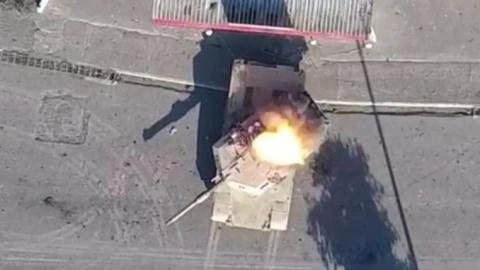The roof of the vehicle is always considered the biggest weakness of a tank, however, each power has its own way of defense.
According to Business Insider, when participating in the war in the Middle East, the US is facing no less than 8 types of anti-tank weapons in Syria.
What is worth noting is that most of these anti-tank missiles originate from Russia, and they are giving American tanks nightmares.
This source said that since 2006, Israel launched modern Merkava tanks to fight the Hezbollah armed forces, but they still suffered huge losses from anti-tank ammunition produced by Russia.
However, in the 2014 Gaza conflict with Hamas, despite using the same Russian weapons, not a single Israeli Merkava tank or armored vehicle was destroyed.
The reason is because Israel has perfected the Active Protection System (APS) called Trophy, through which their tanks are more durable than before.
The moment the `badminton bomb` hit the roof of the M1A1M car.
Meanwhile, the US has not faced a formidable opponent in the past two decades, and as a result, its M1 Abrams tanks do not have APS.
Even if the US can buy and deploy Israel’s Trophy system, they still have to consider many different factors.
Equipped with a sensor system to detect and prevent threats in battlefield conditions that change at breakneck speed, the APS must be able to operate automatically, and thus the risk of damage to the device is increased.
In addition, APS also uses a type of cluster ammunition to stop enemy tanks.
The United States always focuses on protecting the lives and property of military and civilians, so they must find an appropriate solution to satisfy the above problems.
Meanwhile, Russia claims to have nearly completed the T-14 Armata, a battle tank equipped with a large-caliber gun, modern reactive armor and an automatic APS system.
Although the T-14’s capabilities are still a controversial topic, this shows the effectiveness of handheld anti-tank weapons that rebels around the world are using.
To ensure superiority on the battlefield, the US needs to find appropriate solutions to improve the survivability of the armored vehicles it currently has.
During the recent Turkish military campaign to attack terrorism in Syria, IS fighters took advantage of the Leopard 2’s weakness and left this tank dead like a straw.
When studying the bodies of two Leopard 2s burned by IS in the city of Al-Bab, Syria, Turkish experts said that the rebels’ anti-tank missiles easily penetrated the turret from the flanks.
The armor protecting the front of the Leopard 2 tank is quite thick, helping it to withstand direct fire attacks well, but the armor on both sides, especially in the turret position, is quite thin.
And so, along with the armor on the roof and the sides, it is always the biggest weakness of many different tanks.
Clip of US M1A1M tank being hit by rebel `badminton bomb`:
According to Dan Nguyen
Vietnamese land



